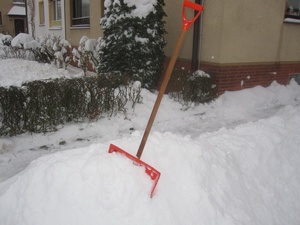7 ways to prevent heart attack, cardiac arrest or stroke while shoveling snow
Cardiologists say the winter storm expected today and tomorrow in the Ann Arbor area will put some individuals at risk for a potentially deadly heart attack, cardiac arrest or stroke as they shovel snow.
“We’re in the bottom of most fitness surveys and in the top of most risk factor surveys such as obesity, percent of smoking,” said Frank Smith, a cardiologist and the director of the Michigan Heart and Vascular Institute at St. Joseph Mercy Ann Arbor. “We’re dealing with a higher risk population in Michigan than perhaps in other areas.”

Photo courtesy of Flickr user Like_the_Grand_Canyon
The colder it is, the heavier the snow, and the weaker the person, the more risk, Rubenfire added.
Cardiac arrest is different from a heart attack, in that the heart stops during an arrest. During a heart attack, a blockage cuts off the supply of blood to the heart, though the heart keeps beating.
And even the fittest can injure their back or shoulder muscles while straining to rid sidewalks and driveways of snow, said Mary Barden, an occupational therapist at St. Joe.
Here are seven ways to prevent injury — and even death — getting that snow off the ground.
1. Avoid shoveling if you have any symptoms of heart disease or have had a heart attack in the past.
Smith said he sees patients who have been told they have symptoms of heart disease, have been feeling fine lately, and go out to shovel snow.
Heart patients or individuals who have ever experienced symptoms of heart disease should not shovel, he said. Those symptoms, called angina, manifest as a tightness or a heaviness in the chest. The condition is also associated with shortness of breath or sweatiness and can be felt as be pain radiating down the arm or into the neck or jaw, said Rubenfire.
It doesn’t take fancy treadmill fitness test to see if a person is fit enough to shovel snow. “Ask them, do you get short of breath walking to the office? Are you short of breath on a flight of stairs?” Smith said. If the answers are yes, then don’t shovel.
Individuals over 65 should leave the shoveling to someone else, Smith said.
2. Be cautious when using snow blowers.
Snow blowers that have to be pushed or are too small for a big job can be physically demanding, too. The self-propelled variety is best for individuals not used to the physical demands associated with clearing pathways after a big snowfall.
3. Dress warmly and in layers.
“Bundle up, and be very warm. Make sure you’re not chilled and that you cover your face with a scarf or a mask. The cold stimulates adrenalin and constricts the blood vessels,” Rubenfire said, which can increase the likelihood of a heart attack, cardiac arrest or a stroke.
4. Hold the booze and caffeine.
Both substances constrict blood vessels and can spike blood pressure.
5. Shovel a little bit at once and ease into it.
Shoveling show for 15 minutes is roughly the equivalent of a half-hour jog at a medium pace, Smith said. Rather than tackle a driveway covered in a foot of snow, Smith recommended shoveling as the snow falls.
The sudden onslaught of physical stress elevates factors that can lead to heart attack, cardiac arrest or stroke, Rubenfire said.
6. Protect your back.
Barden, the occupational therapist, recommends keeping the ears, shoulders and hips aligned when shoveling snow. Don’t twist the back, Barden said, and try to use the legs to do the lifting. That will help prevent muscle injuries in the shoulders and back.
7. Warm-up, hydrate and cool down.
Treat shoveling snow like exercise. To prevent injury, warm up by walking in place and stretching. Stay hydrated and then do a cool down afterward.
Juliana Keeping is a health and environment reporter for AnnArbor.com. Reach her at julianakeeping@annarbor.com or 734-623-2528. Follow Juliana Keeping on Twitter.


Comments
Vandervelde
Wed, Feb 2, 2011 : 6:18 p.m.
One important thing about shoveling heavy snow: Breathe in while loading the shovel and exhale when you throw it. I learned that in pilates.
ChelseaBob
Wed, Feb 2, 2011 : 2:22 p.m.
Shoveling snow is NOT a high risk activity. Getting out of shape is the high risk activity.
Silly Sally
Wed, Feb 2, 2011 : 12:34 p.m.
Far too many kids are too lazy these days to shovel snow, mommy and daddy give them big allowances, stifling any desire to work. Heck, your average UM student has a car bought by mommy and daddy, probably with insurance, gas and repairs thrown in. I've seen some families with teenagers who hire a company to plow their driveway.
Awakened
Wed, Feb 2, 2011 : 11:32 a.m.
8. Pay the neighbor's kid to do it.
Rork Kuick
Tue, Feb 1, 2011 : 9:35 p.m.
Shoveling snow keeps my back in shape for my gardens. If you want to get in great winter shape, move to the Keweenaw. Some places average >240 inches/year, and can see 12 inches/day for days in a row. Now that's 'superior' lake effect.